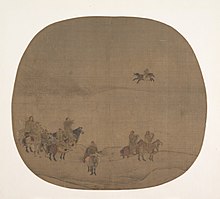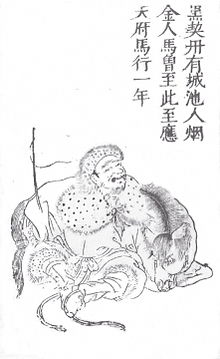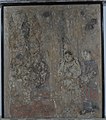Khitan people
hunting with eagles | |
| Regions with significant populations | |
|---|---|
| East and Central Asia | |
| Languages | |
| Khitan, Middle Chinese | |
| Religion | |
| Majority: Chinese Buddhism Minorities: Tengriism, Christianity, Islam | |
| Related ethnic groups | |
| Mongols, Daur |
| History of Manchuria |
|---|
 |
The Khitan people (Khitan small script: ![]() ; Chinese: 契丹; pinyin: Qìdān) were a historical nomadic people from Northeast Asia who, from the 4th century, inhabited an area corresponding to parts of modern Mongolia, Northeast China and the Russian Far East.
; Chinese: 契丹; pinyin: Qìdān) were a historical nomadic people from Northeast Asia who, from the 4th century, inhabited an area corresponding to parts of modern Mongolia, Northeast China and the Russian Far East.
As a people descended from the proto-Mongols through the Xianbei,[1][2] Khitans spoke the now-extinct Khitan language, a Para-Mongolic language related to the Mongolic languages.[3] The Khitan people founded and led the Liao dynasty (916–1125), which dominated a vast area of Siberia, Mongolia and Northern China. The Khitans of the Liao dynasty used two independent writing systems for their language: Khitan small script and Khitan large script.
After the fall of the Liao dynasty in 1125 following the Jurchen invasion, many Khitans followed Yelü Dashi's group westward to establish the Qara Khitai or Western Liao dynasty, in Central Asia, which lasted nearly a century before falling to the Mongol Empire in 1218. Other regimes founded by the Khitans included the Northern Liao, Eastern Liao and Later Liao in China, as well as the Qutlugh-Khanid dynasty in Persia. The modern-day Daur people, a recognized minority ethnic group in Northeast China, are the genetic descendants of Khitans.[4]
The historical name for China, Cathay, originates from the word Khitan.
Etymology
There is no consensus on the etymology of the name of Khitan. There are basically three speculations. Feng Jiasheng argues that it comes from the Yuwen chieftains' names.[5] Zhao Zhenji thinks that the term originated from Xianbei and means "a place where Xianbei had resided". Japanese scholar Otagi Matsuo believes that Khitan's original name was "Xidan", which means "the people who are similar to the Xi people" or "the people who inhabit among the Xi people".[6]
China

Due to the dominance of the Khitans during the Liao dynasty in Manchuria and Mongolia and later the Qara Khitai in Central Asia where they were seen as Chinese, the term "Khitai" came to mean "China" to people near them in Central Asia, Russia and northwestern China. The name was then introduced to medieval Europe via Islamic and Russian sources, and became "Cathay". In the modern era, words related to Khitay are still used as a name for China by Turkic peoples, such as the Uyghurs in China's Xinjiang region and the Kazakhs of Kazakhstan and areas adjoining it, and by some Slavic peoples, such as the Russians and Bulgarians. The Han Chinese consider the ethnonym derived from Khitay as applied to them by the Uyghurs to be pejorative and the Chinese government has tried to ban its use.[7]
History

Origin myth
According to the
Pre-dynastic

The earliest written reference to the Khitan is from an official history of the Xianbei-led Northern Wei dynasty dating to the period of the Six Dynasties. Most scholars believe the Khitan tribe splintered from the Xianbei, and some scholars believe they may have been a mixed group who also included former members of the Xiongnu tribal confederation.[9][10] The Khitan shaved their heads, leaving hair on their temples which grew down to the chest, in a similar fashion to the related Kumo Xi, Shiwei, and Xianbei whom they are believed to be descended from.[11]
During their early history the Khitan were composed of eight tribes. Their territory was between the present-day Xar Moron River and Chaoyang, Liaoning.[12] The Khitan's territory bordered Goguryeo, the Central Plains, and the lands of the Eastern Turks.[13]
Between the 6th and 9th centuries, they were successively dominated by the Eastern Turkic Khaganate, the Uyghur Khaganate, and the Tang dynasty.[14] The Khitans were less politically united than the Turkic tribes, but often found themselves involved in the power games between the Turks and the Sui and Tang dynasties. It is estimated the Khitans had only around 43,000 soldiers – a fraction of the Turkic Khaganates.[13] In 605, the Khitans raided the Sui dynasty, but the Emperor Yang of Sui was able to convince the Turks to send 20,000 horsemen to aid Sui against the Khitans.[15] In 628, under the leadership of tribal chief Dahe Moui, the Khitan submitted to the Tang dynasty, as they had earlier submitted to the Eastern Turks. The Khagan of the Eastern Turks, Jiali Khan, offered to exchange the rebel Liang Shidu for the Khitans, but Emperor Taizong would not agree to the exchange.[12]
During the reign of
Like the Tuyuhun and Tangut, the Khitan remained an intermediate power along the borderlands through the 7th and 8th centuries.[17] The Khitans rose to prominence in a power vacuum that developed in the wake of the Kyrgyz takeover of the Uyghur Khaganate, and the collapse of the Tang dynasty.[18]
Liao dynasty






China was in chaos after the fall of the Tang dynasty in 907. Known as the
The Later Jin dynasty remained a vassal of the Khitans until the death of Shi Jing Tang in 942, but when the new emperor ascended, he indicated that he would not honor his predecessor's arrangement. The Khitans launched a military invasion against the Later Jin in 944. In January 947, the Emperor of the Later Jin dynasty surrendered to the Khitans.[23] The Khitan emperor left the conquered city of Kaifeng and unexpectedly died from an illness while travelling in May 947.[24]
Relations between Goryeo and the Khitans were hostile after the Khitans destroyed Balhae. Goryeo would not recognize the Liao dynasty and supported the fledgling Song dynasty, which had formed south of the Khitans' territory. Though the Khitans would have preferred to attack China, they invaded Goryeo in 993. Khitan forces failed to advance beyond the Chongchon River and were persuaded to withdraw, though Khitan dissatisfaction with Goryeo's conquest of the Jurchen prompted a second invasion in 1010. This time the Khitans, led by their emperor, sacked the capital city Kaesong. A third and final invasion in 1018 was repelled by Goryeo's forces, bringing an end to 30 years of war between the rivals.[25]
The Liao dynasty proved to be a significant power north of the
To defend against the Jurchens and Khitans, a
One of the causes of the Jurchen rebellion and the fall of the Liao was the custom of raping married Jurchen women and Jurchen girls by Khitan envoys, which caused resentment from the Jurchens.[27] The custom of having sex with unmarried girls by Khitan was itself not a problem, since the practice of guest prostitution – giving female companions, food and shelter to guests – was common among Jurchens. Unmarried daughters of Jurchen families of lower and middle classes in Jurchen villages were provided to Khitan messengers for sex, as recorded by Hong Hao.[28] Song envoys among the Jin were similarly entertained by singing girls in Guide, Henan.[29] There is no evidence that guest prostitution of unmarried Jurchen girls to Khitan men was resented by the Jurchens. It was only when the Khitans forced aristocratic Jurchen families to give up their beautiful wives as guest prostitutes to Khitan messengers that the Jurchens became resentful. This suggests that in Jurchen upper classes, only a husband had the right to his married wife while among lower class Jurchens, the virginity of unmarried girls and sex with Khitan men did not impede their ability to marry later.[30] The Jurchens and their Manchu descendants had Khitan linguistic and grammatical elements in their personal names like suffixes.[31] Many Khitan names had a "ju" suffix.[32]
Following the fall of the Liao dynasty, a number of the Khitan nobility escaped the area westwards towards
During the 13th century, the Mongol invasions and conquests had a large impact on shifting ethnic identities in the region. Most people of the Eurasian Steppe did not retain their pre-Mongol identities after the conquests. The Khitans were scattered across Eurasia and assimilated into the Mongol Empire in the early 13th century.[33]
Fleeing from the Mongols, in 1216 the Khitans invaded Goryeo and won several battles, even reaching the gates of the capital, but were defeated by Goryeo General Kim Chwi-ryeo who pushed them back north to Pyongan,[34][35] where the remaining Khitans were finished off by Goryeo forces in 1219.[36][37]

Language and writing systems

The Khitan language is now extinct. Some scholars believe that Khitan is
There were two writing systems for the Khitan language, known as the
Economy
As nomadic Khitans originally engaged in
Religion

The Khitans practiced shamanism in which animals played an important role. Hunters offered a sacrifice to the spirit of the animal they were hunting and wore a pelt from the same animal during the hunt. There were festivals to mark the catching of the first fish and wild goose, and annual sacrifices of animals to the sky, earth, ancestors, mountains, rivers, and others. Every male member of the Khitan would sacrifice a white horse, white sheep, and white goose during the Winter solstice.[43]
When a Khitan nobleman died, burnt offerings were sacrificed at the full and new moons. The body was exposed for three years in the mountains, after which the bones would be cremated. The Khitan believed that the souls of the dead rested at a place called the Black Mountain, near Rehe Province.[44]
Khitan tents always faced east, and they revered the sun, but the moon did not have a large role in their religion.[45] They also practiced a form of divination where they went to war if the shoulder blade of a white sheep cracked while being heated (scapulimancy).[43]
Women
Khitan women hunted, rode horses and practiced archery. They did not practice foot binding, which started becoming popular among the Han during the Song dynasty. The Khitan practiced polygamy and generally preferred marriage within the tribe, but it was not unknown for an Emperor to take wives from other groups, such as the Han, Koreans,[46] and Turkic tribes.[47]
Genetics

A 2015 study postulated that Khitan males may have belonged to haplogroups
A 2020 study published in
Two studies found evidence of Khitan mtDNA ancestry in modern-day people of the Daur ethnicity. This was one of the most significant findings of ethnic studies in China.
Gallery
-
Fresco of a Khitan man
-
Khitans holding wrapped up banners, maces, and drums
-
Khitan mace man
-
Halahaicheng tomb mural
-
Halahaicheng tomb mural
-
Cooks
-
Mural from tomb in Aohan, Liao dynasty
-
Hairstyle
-
Aohan tomb of men preparing drinks
-
Hunters
-
Khitan women, painted on wood.
-
Women
-
Women
-
Woman
-
funerary maskand crown
-
One of the Yixian glazed pottery luohans at the Metropolitan Museum of Art, created in the 12th century during the Liao dynasty.
See also
- History of the Khitans
- List of Khitan rulers
- Yelü
- Liao dynasty
- Northern Liao
- Qara Khitai (Western Liao dynasty)
- Eastern Liao
- Later Liao
- Qutlugh-Khanids
- Cathay
- Mongol mythology
References
Citations
- ^ "China's Liao Dynasty". Asia Society.
- ^ Xu Elina-Qian (2005). Historical Development of the Pre-Dynastic Khitan. University of Helsinki. p. 99. quote: "According to Gai Zhiyong's study, Jishou is identical with Qishou, the earliest ancestor of the Khitan; and Shihuai is identical to Tanshihuai, the Xianbei supreme chief in the period of the Eastern Han (25–220). Therefore, from the sentence "His ancestor was Jish[ou] who was derived from Shihuai" in the above inscription, it can be simply seen that the Khitan originated from the Xianbei. Since the excavated inscription on memorial tablet can be regarded as a firsthand historical source, this piece of information is quite reliable."
- ^ Janhunen, Juha (2006). "Para-Mongolic". In Janhunen, Juha (ed.). The Mongolic Languages. Routledge. p. 393 of pp. 391–402.
- ^ Li Jinhui (2 August 2001). "DNA Match Solves Ancient Mystery". china.org.cn.
- ^ Xu 2005, p. 7.
- ^ Xu 2005, pp. 8–9.
- ^ Starr 2015, p. 43.
- ^ Grayson 2012, p. 124.
- ^ San 2014, p. 233.
- ^ Kim 2013, pp. 61–62.
- ISBN 978-0-521-24331-5.
- ^ a b Hung 2013, p. 144.
- ^ a b Skaff 2012, p. 38.
- ^ a b Biran 2017, p. 153.
- ^ Cohen 2001, p. 64.
- ^ Skaff 2012, p. 48.
- ^ Skaff 2012, p. 39.
- ^ Kim 2013, p. 62.
- ^ Kim 2013, p. 63.
- ^ a b Mote 2003, pp. 12–13.
- ^ Dudbridge 2013, p. 24.
- ^ Hung 2013, p. 22.
- ^ Hung 2013, pp. 23–27.
- ^ Dudbridge 2013, pp. 29–30.
- ^ Kim 2005, pp. 57–58.
- ^ Seth 2010, p. 86.
- ISBN 0791422739.
- ISSN 0069-438X.
- ISBN 0520043839.
- ISSN 0069-438X.
- ISSN 0931-282X.
- ISSN 0931-282X.
- ^ Biran 2017, pp. 152–181.
- ^ "Kim Chwi-ryeo". Encyclopedia of Korean Culture. Academy of Korean Studies. Retrieved 3 July 2016.
- ^ 高麗史 [Goryeosa (History of Goryeo)] (in Literary Chinese). Vol. 103. Retrieved 3 July 2016 – via Wikisource.
- ^ Ebrey & Walthall 2013, p. 177.
- ^ Lee 1984, p. 148.
- ^ Janhunen 2014, p. 4.
- ^ Mote 2003, p. 34.
- .
- ^ Daniels & Bright 1996, pp. 230–234.
- ^ Kara 1987, pp. 19–23.
- ^ a b Baldick 2012, p. 32.
- ^ Baldick 2012, pp. 32–33.
- ^ Baldick 2012, p. 34.
- ^ McMahon 2013, p. 272.
- ^ Twitchett, Denis C.; Herbert Franke; John King Fairbank (1978). The Cambridge History of China: Volume 6, Alien Regimes and... p. 46.
- PMID 25585703. ""The signal of expansion spreads from East to West (from Mongolia to the Caspian Sea), as DC1 has its source in Inner Mongolia (hgC3[xC3c]), DC8 in the Oroqen (hgC3c) and DC10 in the Hezhe (hgN1)." [...] "Interestingly, the westward directions of expansions DC8 and DC10, their potential sources in northeast China, their geographic extents from China to Karakalpakia, and also the Altai-speaking populations associated with them, could also indicate involvement of the Imperial or elite lineages associated with the Khitan Empire."
- PMID 33157037. "Our study includes three Khitan individuals (ZAA003, ZAA005, ULA001) from Bulgan province, all of whom have a strongly eastern Eurasian genetic profile (Figure 2), with <10% west Eurasian ancestry (Figures 3F and and4B;4B; Table S5I). This may reflect the northeastern Asian origin of the Mongolic-speaking Khitan, but a larger sample size is required to adequately characterize the genetic profile of Khitan populations within Mongolia." Haplogroup information found in Table S2, S2C_SexHaplogroups, Supplementary Materials.
- PMID 35585500."Two early genetic studies established a certain genetic relationship between the modern Daur group and the ancient Khitan, which is one of the most significant findings of ethnic studies in China [15, 16]."
- ^ Li Jinhui (8 February 2001). "DNA Match Solves Ancient Mystery". China.org.cn. Retrieved 14 May 2021.
Sources
- Works cited
- Anderson, E. N. (2014). Food and Environment in Early and Medieval China. University of Pennsylvania Press. ISBN 978-0-8122-9009-7.
- Baldick, Julian (2012). Animal and Shaman: Ancient Religions of Central Asia. NYU Press. ISBN 978-0-8147-7165-5.
- Biran, Michal (2017). "7. The Mongols and Nomadic Identity: The Case of the Kitans in China". Nomads as Agents of Cultural ChangeThe Mongols and Their Eurasian Predecessors. Berlin, Boston: University of Hawaii Press. ISBN 978-0-8248-4789-0. Retrieved 2018-02-13.
- Cohen, Warren I. (2001). East Asia at the Center: Four Thousand Years of Engagement with the World. Columbia University Press. ISBN 978-0-231-50251-1.
- Daniels, Peter T.; Bright, William (1996). The World's Writing Systems. New York: Oxford University Press. pp. 230–234.
- Dudbridge, Glen (2013). A Portrait of Five Dynasties China: From the Memoirs of Wang Renyu (880-956). OUP Oxford. ISBN 978-0-19-164967-7.
- Ebrey, Patricia; Walthall, Anne (2013). Pre-Modern East Asia: A Cultural, Social, and Political History. Vol. I: To 1800. Cengage Learning. ISBN 978-1-133-60651-2.
- Kara, György (1987). "On the Khitan Writing Systems". Mongolian Studies: 19–23.
- Hung, Hing Ming (2013). Li Shi Min, Founding the Tang Dynasty: The Strategies that Made China the Greatest Empire in Asia. Algora Publishing. ISBN 978-0-87586-980-3.
- Grayson, James H. (2012). Myths and Legends from Korea: An Annotated Compendium of Ancient and Modern Materials. Routledge. ISBN 978-1-136-60289-4.
- Janhunen, Juha (2014). Mongolian. Amsterdam: John Benjamins. p. 4. ISBN 9789027238252.
- Kim, Hyun Jin (2013). The Huns, Rome and the Birth of Europe. Cambridge University Press. ISBN 978-1-107-06722-6.
- Kim, Djun Kil (2005). The History of Korea. ABC-CLIO. ISBN 978-0-313-03853-2.
- Lee, Ki-Baik (1984). A New History of Korea. Cambridge, Massachusetts: Harvard University Press. ISBN 067461576X.
- Middleton, John (2015). World Monarchies and Dynasties. Routledge. ISBN 978-1-317-45157-0.
- McMahon, Keith (2013). Women Shall Not Rule: Imperial Wives and Concubines in China from Han to Liao. Rowman & Littlefield Publishers. ISBN 978-1-4422-2290-8.
- Mote, Frederick W. (2003). Imperial China 900-1800. Harvard University Press. ISBN 978-0-674-01212-7.
- San, Tan Koon (2014). Dynastic China: An Elementary History. The Other Press. ISBN 978-983-9541-88-5.
- Seth, Michael J. (2010). A History of Korea: From Antiquity to the Present. Rowman & Littlefield Publishers. ISBN 978-0-7425-6717-7.
- Skaff, Jonathan Karam (2012). Sui-Tang China and Its Turko-Mongol Neighbors: Culture, Power, and Connections, 580-800. Oxford Studies in Early Empires. Oxford University Press.
- Starr, S. Frederick (2015). Xinjiang: China's Muslim Borderland. Routledge. ISBN 978-1-317-45137-2.
- Xu, Elina-Qian (2005). "Historical development of the pre-dynastic Khitan". Retrieved 2018-02-13.
- Other webpages
- Khitans
- Khitans on scholar.google.com
- Exhibition of Khitan artifacts
- Khitan gers


















